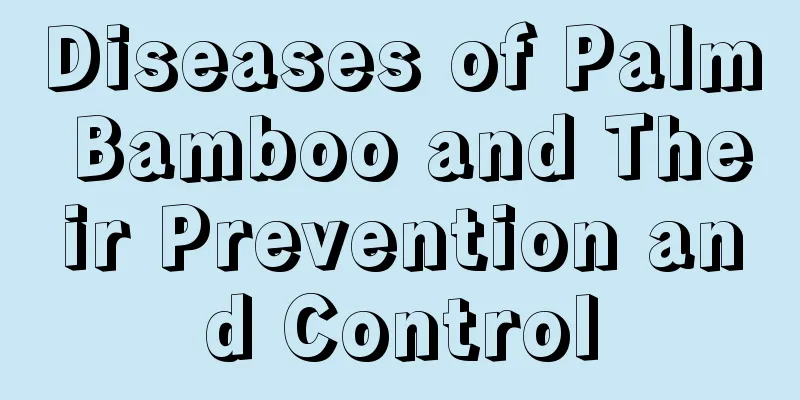Diseases of Palm Bamboo and Their Prevention and Control

Anthracnose of bamboo palmsymptomAnthracnose is one of the important diseases of palm bamboo, which mainly harms the leaves of palm bamboo. When the disease occurs, semicircular or irregular spots will appear on the leaf tips or edges of the bamboo palm, appearing yellowish brown or grayish brown. When the air is too humid, scarlet needle-sized liquid spots will appear on the leaves. Prevention and treatment methodsCombined with winter and spring pruning, clean up the fallen leaves and weeds on the surface of the potting soil. In the early stage of the disease, you can regularly spray 600-800 times diluted Guoguang Yintai wettable powder, Guoguang carbendazim, and thiophanate-methyl for prevention. When the disease is mild, use 400-600 times diluted Guoguang Yingna wettable powder or 500-600 times diluted Guoguang Bixin emulsifiable concentrate for foliar spraying for prevention and control. Use it 2-3 times in a row with an interval of 7-10 days. Diseases of bamboo palm: leaf spot diseasesymptomWhen leaf spot disease occurs in bamboo palm, small yellow-brown spots will initially appear on the leaves, gradually expanding into striped patterns and merging into irregular necrotic spots. The first parts to be affected are the leaf tips and edges. In severe cases, the leaves will shrink and the plant will die. Prevention and treatment methodsStrengthen management, do not apply nitrogen fertilizer alone, and increase the application of potassium fertilizer to improve the plant's disease resistance. In the early stage of the disease, you can spray 300-500 times diluted 50% carbendazim wettable powder once a week for 3 times in a row. Palm bamboo disease - bud rotsymptomBud rot mainly harms young buds and tender leaves. When the disease begins to occur, the unexpanded leaves wither first, turn brown, and then droop. The pathogen spreads from between the young leaves to other parts of the plant, causing the plant to stop growing and slowly rot, emitting a foul odor. The disease mainly occurs in the rainy season, when the temperature is 20℃ to 25℃ and the relative humidity is above 90%. The disease is prone to occur when moisture stays for a long time. Prevention and treatment methodsNormally, ventilation and light transmission should be strengthened to prevent moisture from remaining on the leaves for a long time. In the early stage of the disease, only a small number of diseased leaves are infected. The diseased leaves and stems should be removed in time, sprayed with carbendazim for sterilization, and ventilation should be carried out in time. When the disease is serious, spray 500 times diluted 80% mancozeb wettable powder, or 1:1:100 Bordeaux mixture, and spray the leaves in turn once every 10 days for 3 to 4 times. |
<<: Common diseases and pests of mirror grass and their prevention and control methods
>>: Campanula pests and diseases and control methods
Recommend
When is the best time to take cuttings for roses? How to take cuttings?
1. Cutting time It is best to take cuttings in la...
Management methods of Koelreuteria paniculata seedlings
Maintenance of Koelreuteria paniculata seedlings ...
What to do if the leaves of Ficus microcarpa turn black
1. Watering This plant grown indoors does not nee...
Oh my god! Sprouted garlic has such an effect!
Sprouted garlic may be better for your heart Eati...
What are the cultivation methods and precautions of bird's nest fern
Bird's Nest Fern Introduction Bird's nest...
My hyacinth has a "pinched arrow" problem, and I was worried for a long time. Turns out it's because it's too delicate?
Some friends are interested in hyacinths, but the...
How to judge whether the spider plant needs watering? How to judge whether it is lack of water or too much water
The method of planting spider plants must be corr...
When and how to plant tulips
1. Planting time Usually, tulips are planted in a...
How to grow tulips in water
1. Breeding methods 1. Container: For hydroponic ...
How to grow long-leaf fern
1. Cultivation medium When cultivating long-leaf ...
How to reproduce Venus flytrap
Sexual reproduction of the Venus flytrap The Venu...
Common causes and treatment methods of yellowing leaves of asparagus fern
1. Common causes Improper water management, light...
Breeding method of Zephyranthes
1. Loosen the soil When cultivating Zephyranthes,...
Not only can you grow flowers at home, but you can also grow melons
Loofah (A little selfish~) Don’t ask Huahua why I...
An introduction to the advantages and disadvantages of Misaki roses. Is Misaki rose difficult to grow?
Rose cultivation has a long history in China and ...









